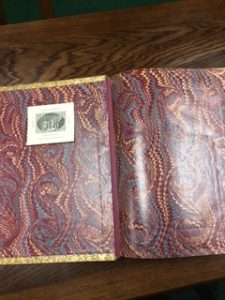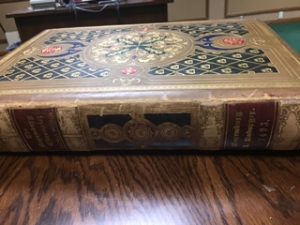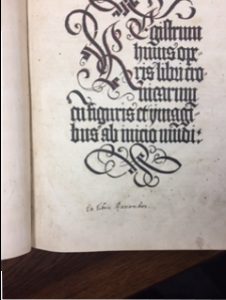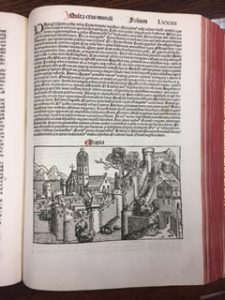

For this assignment I decided to turn back to the Nuremberg Chronicles, originally written in Latin by Hartmann Schedele and printed by Anton Koberger in 1493. This work to me was the most interesting from a bibliographical stand point because it is actually a block book. Block books are pages of text and images cut into a wooden block and then transferred onto paper. A single block would be used for an entire page. Generally, and in the case with the Nuremberg Chronicles, two pages were printed on one side of a single sheet of paper. This sheet was then folded in half and the two sides were glued together so that the blank sheets on the inside were joined. In this book there are a total of 1,809 woodcuts from 645 blocks. There are a total of 300 pages in the Nuremberg Chronicles and the thread used to bound the 150 sheets shows an obvious case of stab-stitching. MSU’s copy had been so well preserved by the Moore family that the binding and the original leather cover are still intact. Because most block books are undated, bibliographers compared the books watermarks to that of dated documents and determined that mid-15th century Europe was the prime time for this style of press.


Although most of what I learned about block books and woodblock printing was through research, the Nuremberg Chronicles gives a visual and physical example of what I had studied. The deep impressions of the words and images are choppy yet soft, helping me visualize the carved block pressing into the paper like a stamp. The paper appears to be woven because there aren’t any chainlines. Because two blank sides of the pages are glued together, I would assume no one has ever seen them but there is no evidence of any of the pages being detached. There are several beautiful two page spread images, including a two paged map of Europe. Most of the book contains elaborate and colorful half sized images which is typical of woodblock press. The edges were all trimmed and only slightly worn but again, the book was so well preserved that it looks virtually untouched.
Sources:
http://education.asianart.org/explore-resources/background-information/invention-woodblock-printing-tang-618–906-and-song-960–1279
https://www.abebooks.com/servlet/SearchResults?pics=on&sortby=1&tn=Nuremberg%20Chronicle
